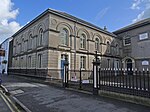Carmarthen Bridge
Bridges completed in 1937Bridges completed in the 13th centuryBridges in CarmarthenshireBridges over the River TowyBuildings and structures in Carmarthen ... and 6 more
Concrete bridges in WalesGrade II listed bridges in WalesGrade II listed buildings in CarmarthenshireRebuilt buildings and structures in WalesRoad bridges in WalesUse British English from March 2017

Carmarthen Bridge (also known locally as the Towy Bridge or Town Bridge) is the modern 1930s road bridge crossing the River Tywi in Carmarthen, Wales, carrying the A484 road.
Excerpt from the Wikipedia article Carmarthen Bridge (License: CC BY-SA 3.0, Authors, Images).Carmarthen Bridge
Carmarthen Bridge,
Geographical coordinates (GPS) Address External links Nearby Places Show on map
Geographical coordinates (GPS)
| Latitude | Longitude |
|---|---|
| N 51.8547 ° | E -4.3045 ° |
Address
Carmarthen Bridge
Carmarthen Bridge
SA31 2BN , Llangunnor
Wales, United Kingdom
Open on Google Maps











